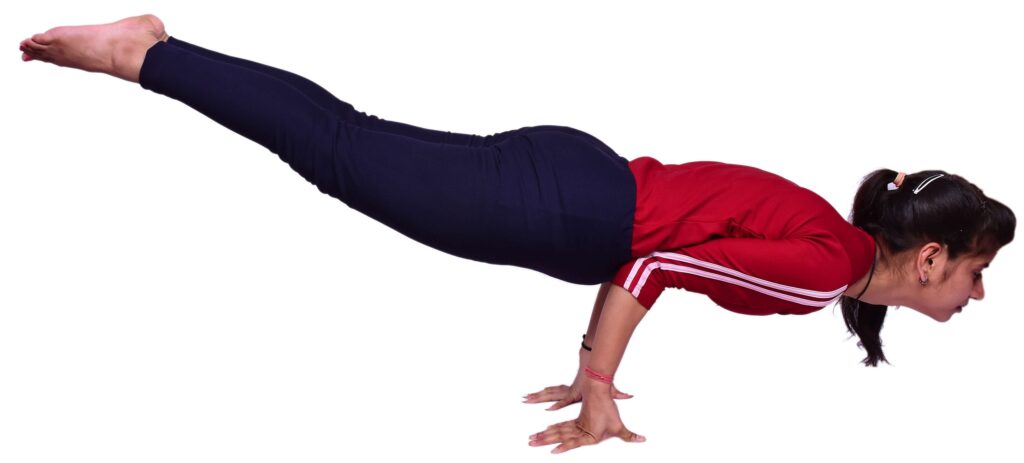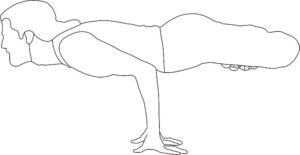Meaning of Peacock Pose
- Peacock pose is also known as Mayurasana.
- Mayurasana is a Sanskrit word.
- The pose is pronounced as ‘ma-yur-AHS-anna’.
- Mayur means ‘peacock’ and asana indicates ‘yoga pose.’
- This yoga emulates the mechanism of the Mayur bird in the final pose with full plumage. Therefore, it is known as the peacock pose.
What is a Peacock Pose?
- Peacock pose is a balancing advanced yoga asana.
- The practice of the yoga pose requires a greater degree of muscular strength and flexibility.
- The pose has the power to absorb toxins from the body. Thus, it ensures the removal of toxins from the practitioner’s body.
- Mayurasana is one of the best yoga poses for eliminating all abdominal ailments.
Peacock pose introduction

After much research and discussion with yoga teachers and experts, the article is being presented before you. Besides this, I am also sharing my personal experience after practising yoga for the last 20 years. You will get here to know what peacock pose is, how to do it, and its benefits and precautions. The easily explained steps, blessings, protection, images, and informative cum instructional videos of peacock pose will help you to understand the posture technically correctly, thereby extracting maximum benefits from it.
How to do peacock pose step-by-step instructions
Though it’s an advanced yoga pose, its more straightforward step-by-step technique has been mentioned below.
- Kneel on the floor with separated knees and feet together.
- Place both palms on the floor between the knees with fingers pointed back towards the feet.
- Ensure the wrists and forearms should be together.
- Lean forward and try to rest the abdomen on the top of the elbows, and the chest rests on top of the upper arms.
- Inhale; slowly elevate the trunk, head, and legs to lie in one straight and horizontal line.
- This is the final pose, and hold it as long as you feel comfortable.
- Slowly return the legs to the ground and come to the original position.
- Do 2-3 rounds.
Breathing, Awareness, and Duration
While raising the body, inhale deeply. Do slow inhaling and exhaling while maintaining the pose. In addition, beginners can hold their breath in the final pose at their convenience. Exhale and come to the original position slowly. Awareness should be on balance while performing the yoga asana. Beginners should stay only for a few seconds. Duration should be increased gradually. Do a maximum of three rounds. The maintenance of the yoga pose can be improved for a few minutes, but do it without strain.
Muscular movement
Abdominal muscles bear the pressure of the elbows into the viscera; pelvic floor muscles; deep intrinsic muscles in the neck to find cervical extension while maintaining thoracic flexion; all spinal extensors work. Hamstrings to extend the hips and gluteus medius, minimus, and maximus help with extension. Infraspinatus and teres minor rotate the humerus. Subscapularis and supraspinatus help to protect the front of the joint.
Peacock pose by Baba Ramdev
Many yoga teachers like Baba Ramdev and BKS Iyengar do this with some variations. Their techniques and instructions are being given here.
- Iyengar yoga: In the Iyengar school of yoga, the entire body is in a straight and horizontal line.
- Vinyasa yoga: It is similar to Iyengar yoga.
- Ashtanga yoga: It is similar to the technique mentioned above.
- Baba Ramdev yoga: It is the same as the abovementioned technique.
- Art of living: It is similar to Ashtanga yoga, but the head is slightly lower.
- Power yoga: The main focus is given on stretching the posture.
- Hot yoga: It is similar to power yoga but more strenuous.
- Satyananda yoga: It is similar to the technique mentioned above.
- Bikram yoga: The body seems more straight and synchronised here.
10 wonder benefits of peacock pose
- Toxins: Asana can remove and eliminate toxins from the body, thus rejuvenating cells and tissues by extracting and purifying the blood.
- Blood circulation: The Yoga pose stimulates the entire body processes, thereby increasing blood circulation and metabolism.
- Fair complexion: It helps glow the face by removing toxins from the body and boils, pimples and wrinkles from the facial region.
- Diabetes: The practice of the asana ensures adequate massage to the pancreas and other organs of the body, helping prevent and manage diabetes.
- Constipation and flatulence: It helps to combat constipation and flatulence by stimulating and massaging the digestive-related organs. It also makes the digestive system efficient by increasing the digestive fire and eliminating the toxins consumed through diets.
- Weight loss: The asana requires more excellent stretching and flexibility into the entire body region. Practising and maintaining the pose for a certain period enables one to overcome obesity.
- Liver: It also helps to make your liver fresh, refreshed and rejuvenated.
- Kidney: The asana compressed the kidney, removing stagnant blood and enhancing the kidneys’ efficiency.
- Flat stomach: The regular practice of peacock pose helps to burn belly fat.
- Muscle strengthening: Gradually, the asana makes our muscles more robust and powerful, especially the powers of the arms, abdomen, and spine.
Contraindications
Some of the few limitations of this advanced yoga pose are:
- There is a greater probability of falling forward from the final pose, and it can damage your nose and teeth. Therefore, one should be careful while practising it.
- It is better to keep the cushion forward during practice.
- During high blood pressure, it shouldn’t be practised.
- Heart disease patients should avoid this.
- Skip performing the pose in case of a hernia.
- Avoid in case of peptic ulcer.
- Duodenal ulcer
- One shouldn’t try in case of physical weakness.
- Pregnant women should strictly avoid it.
Beginner’s tip
While performing the Mayurasana, the entire body weight solely rests upon the elbows and palms, which is extremely difficult for beginners as it requires greater muscular strength. So, it is recommended that beginners, first of all, prepare themselves by doing Hamsasana / Padma Mayurasana or Chakrasana.
Peacock pose sequence
Preparatory pose
- Tadasana
- Stickasana
- Boat pose
- Chakrasana
- Hamsasana
- Padma mayurasana
- Shalbhasana

Follow-up / counter pose
- Makrasana
- Shavasana
- Markatasana
Top facts about peacock pose
Here, we will mention the points to be remembered, tips, and mistakes to be avoided while practising the yoga pose.
- It is said that those who perform this pose can even digest poison.
- It is one of the few yoga poses which removes toxins naturally from the body.
- It should be performed at the last of yogic practices.
- Never perform inverted poses like Sirsasana, Sarvangasana, etc., after Mayurasana because of the greater possibility of accumulating toxins in the brain.
- The whole body should be balanced on the palms.
- The practising of this Yoga pose helps to improve other postures.
- It strengthens your arms and wrists.
- It stimulates Manipura Chakra.
- The Asana tones and strengthens the abdominal muscles and organs.
- It is a panacea for diabetes.
The Science Behind Mayurasana
It is said that the practice of Mayurasana can even tackle poison. This is true that the asana removes toxins, poisons, and all impurities from the body, thus increasing the work efficiency of various body organs. The pose also massages the liver, kidney, pancreas, and other abdominal organ
Modification and variations
- Hamsasana: It is also known as the swan yoga pose, which strengthens the arms.
- Padma Mayurasana: It is the advanced version of Mayurasana, good for arms and wrists.
- Half peacock pose: Here, only one leg is raised.
- Peacock pose with blocks
Precautions
- Menstruation
- Intestinal problems
- High blood pressure
- Pregnancy
- Hernia
- Piles
- Infections in the ear and nose
Peacock pose information
| Sanskrit name | मयूरआसन |
| English name | Peacock pose |
| Pronunciation | ma-your-AHS-anna |
| Pose level | Advanced |
| Areas of actions | s, wrists, forearms |
| Style of yoga | Hathayoga |
| Position | Prone |
| Type | Strength, Balance |
| Chakras | Third eye chakra (Ajna Chakra) |
| Element | light |







This is really interesting, You’re a very skilled blogger. I’ve joined your feed and look forward to seeking more of your magnificent post. Also, I’ve shared your site in my social networks!